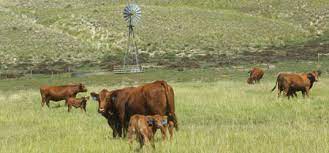- Karla H. Wilke, UNL Cow/Calf Systems and Stocker Management
- Mary Drewnoski, Nebraska Extension Beef Systems Specialist
As spring nears and grass begins to turn green, producers are anxious to get cows out to grass. However, cool season predominate areas tend to have lush spring growth which can lead to grass tetany in cows. While there are treatments for cows caught quick enough, prevention is always the best policy.
Why are cows at risk of grass tetany in the spring?
Grass tetany occurs when circulating Magnesium (Mg) is low in the beef animal. Symptoms include staggering, convulsions, excitability, twitching, and can result in death. While it can affect growing cattle, it generally affects older lactating cows. The Mg requirement in the pregnant cow is 0.12% of the diet on a dry matter basis and jumps to 0.20% with lactation. Moreover, the Mg in colostrum is 3 times what it is in the milk the rest of the lactation. Thus, risk is highest early in lactation.
Additionally, unlike some other minerals, Mg is not stored and mobilized in the tissues for times when it is deficient in the diet. Magnesium is absorbed across the rumen wall and how much Mg is circulating in the blood is highly dependent upon how much was consumed.
In addition to the fact that the Mg requirement increases with lactation, feed that is high in potassium (K) or nitrogen (N) like lush rapidly growing cool season forages can decrease Mg absorption. So, more magnesium needs to be consumed when cows are grazing lush cool season pastures to get the same amount of magnesium into the blood. Furthermore, cool, cloudy days associated with wet springs often times increase the risk of grass tetany.
Using free choice minerals to prevent grass tetany
To help prevent issues with grass tetany, producers should start providing a high Mg mineral to cows about a month before turning out on lush pasture to get them used to consuming it, and continue to provide high Mg supplement until grass starts to elongate and mature and the risk of grass tetany is low.
Mineral mixes are typically formulated for 2 oz or 4 oz intake. At 2 oz intake, 100 cows should consume 87.5 lbs of mineral mix per week and 175 lbs/week for a 4 oz mineral mix. If they are eating more, then adding more salt will often decrease intake. However, the salt will dilute the mix so overall intake (salt plus mineral mix) should be greater than the initial target. Keep track of the actual mineral mix intake to ensure target intakes are reached. When using a free choice mineral mix to provide magnesium, do not provide separate salt as providing separate salt will reduce intake of the mineral mix.
To prevent grass tetany, a good target for a 4 oz target intake free choice mineral is 10 to 13% Mg. If adding magnesium to an existing mineral, then 9 lbs of magnesium oxide per 50 lbs of mineral mix would be needed. However, magnesium oxide is bitter and may reduce intake. If intake is low, then adding 1 lb of dried distillers or soybean meal may help increase intake.
Using a hand fed supplement to prevent grass tetany
If using a hand-fed energy or protein supplement, then 5 lb of Magnesium oxide per 100 cows would need to be added. Sodium deficiency can increase the risk of magnesium deficiency, so if using a mineral fortified supplement that is provided daily, such as a cake (and not a free-choice mineral) make sure that free choice salt is provided.
While providing high Mg mineral helps reduce the incidence of grass tetany, producers should talk to their local veterinarian and have a treatment plan in place for cows who do succumb to grass tetany, as treatment must take place quickly in those cows.
For more information on meeting the mineral and vitamin needs of beef cows, see G2340 Formulation Considerations for Mineral and Vitamin Supplements for Beef Cows














